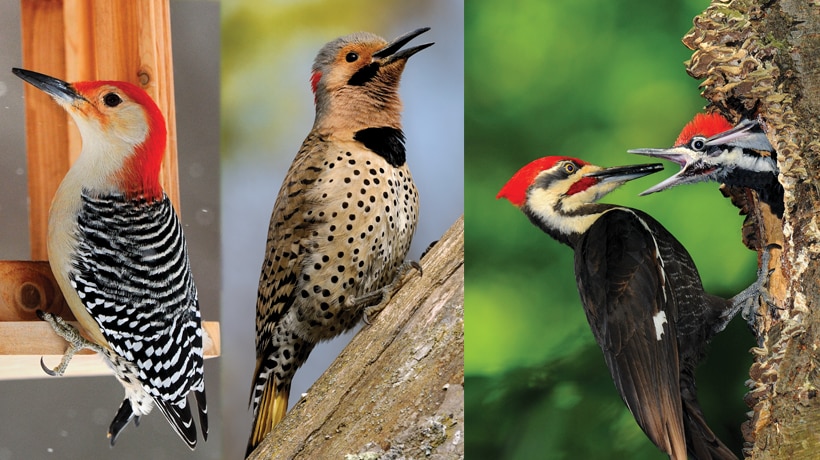Understanding Woodpeckers in Florida: Actions, Species, and Habitats
Understanding Woodpeckers in Florida: Actions, Species, and Habitats
Blog Article
Discover the Remarkable Globe of Woodpeckers: Whatever You Required to Know
The globe of woodpeckers is a world loaded with one-of-a-kind actions, intricate adaptations, and a diverse variety of types. From their habitats and distribution patterns to their feeding routines and specialized physiological functions, woodpeckers have long captivated the passion of ornithologists and nature fanatics alike.
Woodpecker Habitats and Circulation
Woodpeckers populate a diverse series of environments worldwide, showcasing versatility in their circulation patterns. These resilient birds are discovered in woodlands, forests, savannas, and deserts across various continents, demonstrating their ability to thrive in various weather conditions. In The United States and Canada, for instance, woodpeckers can be identified in both coniferous and deciduous forests, utilizing their solid beaks to forage for insects and create nesting cavities in trees. In a similar way, in Africa, specific woodpecker types have adapted to dry settings, such as the acacia forests, where they play a critical role in controlling insect populations.

Feeding Behaviors and Diet Plan
Amongst the different elements of their habits, woodpeckers show distinctive feeding behaviors and nutritional choices. These birds are mostly insectivores, with a diet regimen that consists of ants, beetles, caterpillars, and various other bugs discovered in trees. Woodpeckers use their strong beaks to drill into the bark of trees, penetrating for pests and larvae concealed underneath the surface area. Along with insects, woodpeckers also consume nuts, seeds, fruits, and sap. Some species have actually specialized tongues with barbed tips that aid them remove pests from gaps in timber.
Woodpeckers are recognized for their drumming habits, which serves not only to interact with other woodpeckers but additionally to situate food. The quick drumming audio is created by the bird pecking on resonant surfaces like dead trees or metal poles. This behavior can attract pests concealed in the wood, allowing the woodpecker to find their existence and prey on them.
One-of-a-kind Adjustments for Tree Climbing
In their proficient quest of pests concealed within tree bark, woodpeckers have actually advanced remarkable anatomical functions that outfit them with special adjustments for here are the findings reliable tree climbing. Woodpeckers have solid neck muscles and a distinct head structure that soak up the impact of continuous pecking, enabling them to climb up vertically without creating harm to their brains. These adaptations showcase the amazing evolutionary design that enables woodpeckers to navigate trees with precision and performance.
Diverse Woodpecker Variety Worldwide
With over 200 various varieties spread out across different habitats worldwide, the family of Picidae encompasses an amazing diversity of woodpeckers. These find this birds can be found in woodlands, timberlands, savannas, and also city locations, showcasing their adaptability to different environments. From the iconic Northern Flicker in The United States And Canada to the vivid and evasive Crimson-backed Flameback in Asia, each woodpecker types displays unique characteristics in terms of tuft, actions, and habitat choice.
Woodpeckers vary considerably in dimension, with the petite Downy Woodpecker measuring around 6-7 inches in length, while the effective Lineated Woodpecker can reach up to 17 inches - Woodpeckers in Florida. Their beaks also are available in various see this website forms and sizes, mirroring their feeding routines. Some varieties concentrate on removing insects from tree bark, like the Acorn Woodpecker, while others, such as the Black-cheeked Woodpecker, feed on fruits and seeds

Preservation Efforts and Obstacles
Conservation efforts for woodpecker populations are vital in reducing the impact of habitat loss and various other hazards dealing with these varied bird species. Woodpeckers deal with numerous difficulties to their survival, largely as a result of deforestation, urbanization, environment modification, and invasive varieties. To deal with these issues, conservation efforts concentrate on protecting and recovering woodpecker environments, implementing sustainable forestry practices, and raising understanding concerning the relevance of these birds in ecological communities.
One considerable difficulty in woodpecker preservation is the fragmentation of their habitats, causing isolated populations that are a lot more susceptible to termination - Woodpeckers in Florida. Guardians work to produce wild animals hallways and shielded areas that connect these fragmented habitats, allowing woodpeckers to move between various locations for feeding, breeding, and sanctuary

Verdict
In final thought, woodpeckers are interesting birds with special adjustments for tree climbing and feeding behaviors. Further study and conservation actions are needed to guarantee the survival of woodpeckers in the wild.
Report this page